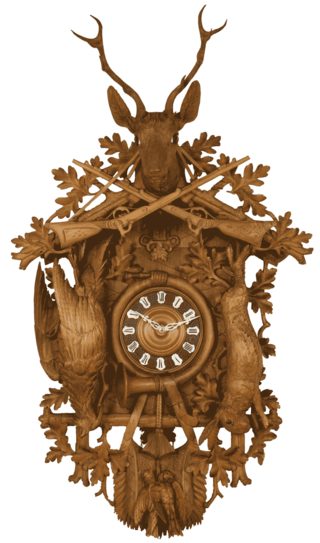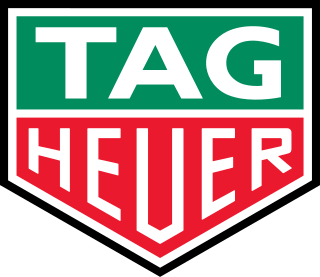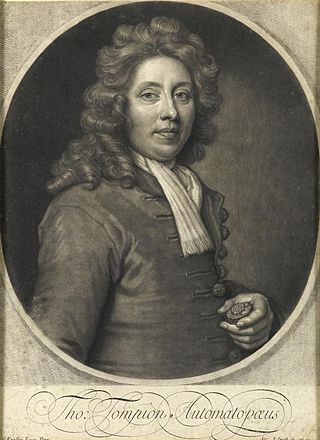
A watch is a portable timepiece intended to be carried or worn by a person. It is designed to keep a consistent movement despite the motions caused by the person's activities. A wristwatch is designed to be worn around the wrist, attached by a watch strap or other type of bracelet, including metal bands, leather straps, or any other kind of bracelet. A pocket watch is designed for a person to carry in a pocket, often attached to a chain.

A cuckoo clock is a type of clock, typically pendulum driven, that strikes the hours with a sound like a common cuckoo call and has an automated cuckoo bird that moves with each note. Some move their wings and open and close their beaks while leaning forwards, whereas others have only the bird's body leaning forward. The mechanism to produce the cuckoo call has been in use since the middle of the 18th century and has remained almost without variation.

A timer or countdown timer is a type of clock that starts from a specified time duration and stops when reaching zero. A simple timer is an hourglass. Commonly, a timer triggers an alarm when it ends. A timer can be implemented through hardware or software. Stopwatches operate in the opposite direction, upwards from zero, measuring elapsed time since a given time instant. Time switches are timers that control an electric switch.
Timex Group USA, Inc. is an American global watch manufacturing company founded in 1854 as the Waterbury Clock Company in Waterbury, Connecticut. In 1944, the company became insolvent but was reformed into Timex Corporation. In 2008, the company was acquired by Timex Group B.V. and was renamed Timex Group USA.

Seiko Group Corporation, commonly known as Seiko, is a Japanese maker of watches, clocks, electronic devices, semiconductors, jewelry, and optical products. Founded in 1881 by Kintarō Hattori in Tokyo, Seiko introduced the world's first commercial quartz wristwatch in 1969.
A grandfather clock is a tall, freestanding, weight-driven pendulum clock, with the pendulum held inside the tower or waist of the case. Clocks of this style are commonly 1.8–2.4 metres (6–8 feet) tall with an enclosed pendulum and weights, suspended by either cables or chains, which have to be occasionally calibrated to keep the proper time. The case often features elaborately carved ornamentation on the hood, which surrounds and frames the dial, or clock face.

TAG Heuer S.A., founded Heuer AG is a Swiss luxury watchmaker. Founded in 1860 by Edouard Heuer in St-Imier, Switzerland, it was acquired by Techniques d'Avant Garde in 1985, which purchased a majority stake in the company, forming TAG Heuer. In 1999, French luxury goods conglomerate LVMH bought nearly 100 percent of the Swiss company.The name TAG Heuer combines the initials of "Techniques d'Avant Garde" and the founder's surname.

In horology, a movement, also known as a caliber or calibre, is the mechanism of a watch or timepiece, as opposed to the case, which encloses and protects the movement, and the face, which displays the time. The term originated with mechanical timepieces, whose clockwork movements are made of many moving parts. The movement of a digital watch is more commonly known as a module.

Chauncey Jerome (1793–1868) was an American clockmaker in the early 19th century. He made a fortune selling his clocks, and his business grew quickly. However, his company failed in 1856, and he died in poverty.

Eli Terry Sr. was an inventor and clockmaker in Connecticut. He received a United States patent for a shelf clock mechanism. He introduced mass production to the art of clockmaking, which made clocks affordable for the average American citizen. Terry occupies an important place in the beginnings of the development of interchangeable parts manufacturing. Terry is considered the first person in American history to actually accomplish interchangeable parts with no government funding. Terry became one of the most accomplished mechanics in New England during the early part of the nineteenth century. The village of Terryville, Connecticut is named for his son, Eli Terry Jr.

Thomas Tompion, FRS (1639–1713) was an English clockmaker, watchmaker and mechanician who is still regarded to this day as the "Father of English Clockmaking". Tompion's work includes some of the most historic and important clocks and watches in the world, and can command very high prices whenever outstanding examples appear at auction. A plaque commemorates the house he shared on Fleet Street in London with his equally famous pupil and successor George Graham.
The Howard Miller Company is a Zeeland, Michigan, based manufacturer of longcase clocks and other home furnishings.
The Ansonia Clock Company was a clock manufacturing business founded in Ansonia, Connecticut, in 1851 and which moved to Brooklyn, New York, in 1878. The company has produced hundreds of different clock models, including Gingerbread, Porcelain, and Crystal Regulator styles. The business shut down in 2006.

The term American clock refers to a style of clock design. During the 1600s, when metal was harder to come by in the colonies than wood, works for many American clocks were made of wood, including the gears, which were whittled and fashioned by hand, as were all other parts. There is some evidence that wooden clocks were being made as early as 1715 near New Haven. Benjamin Cheney of East Hartford, Connecticut, was producing wooden striking clocks by 1745.

E. Howard & Co. was a clock and watch company formed by Edward Howard and Charles Rice in 1858, after the demise of the Boston Watch Company. The pair acquired some of the material and watches in progress, based upon a lien against the defunct company held by Rice, but they were unable to buy the existing factory or machinery, so they moved to Roxbury. Soon afterwards, Howard bought out Rice's interest and thereafter sought to make high quality watches based on his own unique designs and eccentric production methods. E. Howard & Co. also produced regulators, and marine clocks.
The evolution of U.S. manufacturing and the American industrial revolution are clearly reflected in the history of Connecticut. Between the birth of the U.S. patent system in 1790 and 1930, Connecticut had more patents issued per capita than any other state; in the 19th century, when one in three thousand people were issued a U.S. patent, one in 700-1000 Connecticut inventors were issued patents. Connecticut's first recorded invention granted a U.S. patent was a lapidary machine, by Abel Buell of Killingworth, in 1765.

Gallet (ˈgæl.eɪ) is a historic Swiss manufacturer of high-end timepieces for professional, military, sports, racing, and aviation use. Gallet is the world's oldest clock making house with history dating back to Humbertus Gallet, a clock maker who became a citizen of Geneva in 1466. The Gallet & Cie name was officially registered by Julien Gallet (1806–1849) in 1826, who moved the family business from Geneva to La Chaux-de-Fonds, Switzerland. Prior to this date, operations commenced under the name of each of the Gallet family patriarchs.

Lux Products is a thermostat brand of Johnson Controls Inc.
MeisterSinger is a manufacturer of mechanical wristwatches. The company is based in Münster, Germany. Annual sales are claimed to be 10,000 pieces.












